Four cans of Heineken on the 4am bus from Waterford to Dublin Airport.
A pint of Guinness while waiting for the flight to Palma, on the Spanish island of Majorca.
Three pints of Amstel on arrival, at about 2pm, in the beach resort of Santa Ponsa, in a bar beside their apartment complex, the Deya, one of the most popular package destinations for the post-Leaving Cert students who come to the town in their thousands each summer.
After the bar a visit to a supermarket next door.
Fourteen bottles of Heineken in their apartment. “I didn’t drink them all. There were 24 in the box.”
Six bottles of some local beer. “I can’t remember the name of them.”
One litre of local vodka, Rushkinoff.
A large premixed bottle of “some blue cocktail thing”.
After the apartment an indeterminate number of sambuca shots in a nightclub at 4am.
“That’s when I got sambuca-ed,” the pale lanky boy from Waterford tells me, swigging from a bottle of water, sitting in a cafe opposite the apartment complex. “He means sick,” his friend explains cheerfully. This friend admits he also vomited, but is not as eager to give a list of all he drank.
The lanky boy is so keen to list his drinks that he carefully writes them in my notebook, along with volume and price: 250ml for both the Heineken and the local beers, and €6.95 for the litre of local vodka.
A third member of the Waterford party is a slight, dark-haired boy whom his “sambuca-ed” friends describe as a king. This is because he is the one who shepherded the other two back to their apartment after they threw up and their night was finally over. There are five more in their group, all still in bed at 1pm.
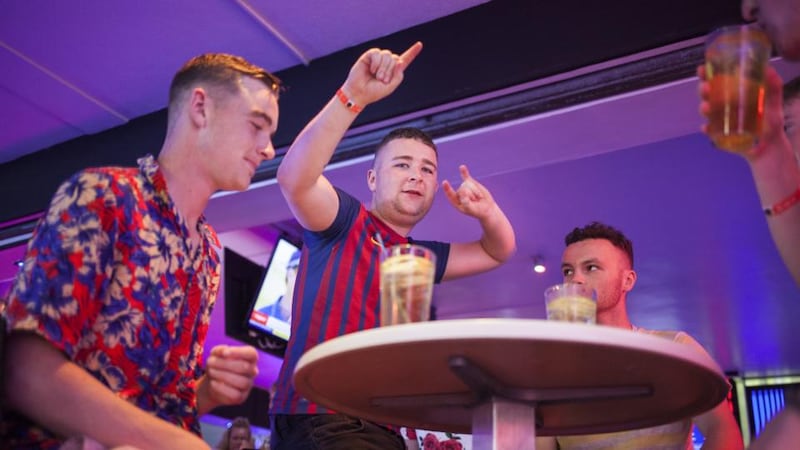
The Balearic island has been a popular destination for several years for Irish students who have just finished their exams. The many who stay in Santa Ponsa also make night-time forays to Magaluf, the resort, just under 10km away, where the rest of each summer's Irish student visitors stay, usually in the TRH apartment complex.
Although they are only a short distance apart, the two beach resorts are different. Magaluf is edgier, noisier, dirtier, bigger and more aggressive, and it has what Santa Ponsa does not: “the Strip”, or Punta Ballena, a frenetic neon-lit street lined with lap-dancing clubs, tattoo parlours, bars, clubs and fast-food restaurants.
One end of it is closed off, with a police van in place, to guard against potential terrorist attacks with vehicles: at night the street is always crammed with partying pedestrians.
In the two days I shuttle between the two resorts, I see a lot of boys wearing GAA jerseys in Santa Ponsa. In Magaluf I see none. Here, the T-shirts for sale proclaim slogans such as “I Love Sluts”, “Made in the UK, Destroyed in Magaluf” and “Virginity can be Cured”.
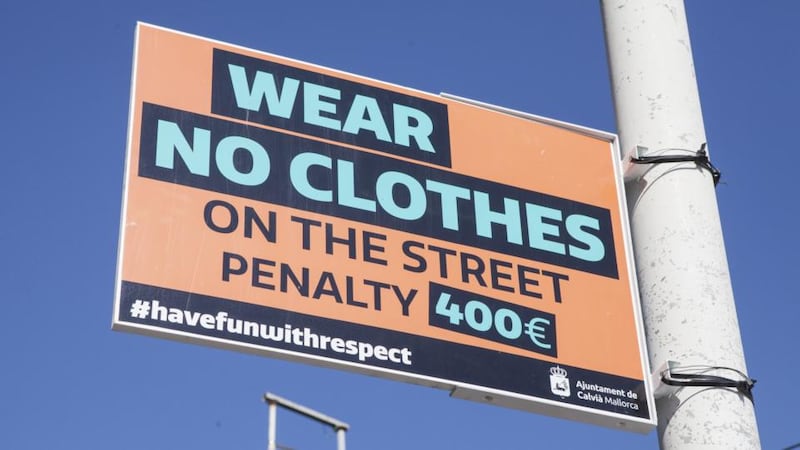
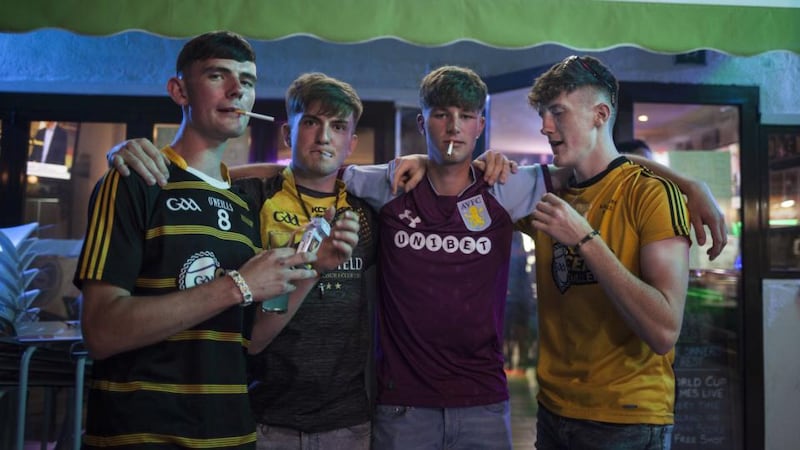
In a recent effort to curtail some of the more outrageous behaviour on the streets both in Magaluf and Santa Ponsa, fines have been introduced for public disorder. Signs on lamp posts proclaim: “Wear no clothes on the street, penalty €400”; “Shout, fight or bother people, penalty €400”.
Virtually all of the many supermarkets stock about three times as much wine, beer and spirits as they do food. The shelves are crammed with local brands of alcohol, most in plastic bottles.
There’s a bottle of something green with a naked woman on the front, crouched over a cannabis plant, called “Bewitched Cannabis Absinthe”. Tunel is another green liquid, a local herb liqueur whose bottle makes it look a little like floor polish.
Rushkinoff, the local vodka, turns up in all kinds of cocktail mixes, including a lurid pink Sex on the Beach. It is unclear what the ingredients in some of these cocktail bottles are, or how strong they are; one typical label refers vaguely to “vodka with aromas of peach, orange and grenadine”. But all are cheap: a litre varies in price from €6.95 to €9.95.
“Young people who come to Majorca drink too much,” says Pilar Rubio, who lives in Palma. Rubio has been a doctor with the public ambulance service, Samu 061, for more than 20 years. Magaluf has three ambulances, “but it is never enough”, she says.
Dozens of people, mainly young men, have died in Majorca in recent years from a practice known as balconing. This involves jumping down from one hotel or apartment balcony to the next, or sometimes jumping from a balcony towards a swimming pool, and missing the pool.
Rubio says five tourists so far have died this month in falls from balconies. “It’s not a new craze,” she says. “My first ambulance call, 21 years ago, was to someone who had fallen after trying to climb between balconies.”
Rubio dislikes the party culture that has developed in the resort. “For us it is a bad tourism, but local people make a lot of money from young people. Spanish people do not come to Magaluf.”
If the person is unable to walk, the ambulance will take them to hospital for the night. Emergency staff are regularly hit over the head with bottles
Most of the emergencies she attends are not life-threatening, but almost all are alcohol-related. The calls start coming in at 2am. They usually consist of “people drinking too much and falling down unconscious on the street”.
If the person is unable to walk, the ambulance will take them to the hospital in Palma for the night. They no longer allow friends to accompany the casualty. “People were fighting in the ambulance. It was too dangerous.”
Emergency staff are regularly hit over the head with bottles. Most people the ambulance service attends in Magaluf are English-speaking, but as Pilar can’t distinguish between British and Irish accents she isn’t sure how many Irish people are involved.
Even when medical staff are attending an ill patient “the young people say rude words. They are not polite at all. They sometimes throw their drinks in our faces, or into the ambulance,” she says. “Then they go back to their countries, and say to their friends, come here to Majorca to party, and to drink, drink, drink.”
It’s afternoon in Santa Ponsa, where you will find plenty of English breakfasts, pizza, chips, burgers, kebabs and pasta on offer. There are also some sushi bars, fish restaurants, and menus offering a wide range of salads. There are far more families in evidence, too, with small children in strollers, and a more laid-back atmosphere.
Eva Griffin, Aishling Kennedy, Elke Bergin, Lisa Bergin and Jane Minehan, who are all from Nenagh, in Co Tipperary, are having a late breakfast in a cafe near the Deya apartments. Another 12 of their friends will arrive the next day, bringing the group up to about 25 people. The girls have been here for five days.
“It’s not as bad as people say it is here,” Elke Bergin says. “It’s so nice to be able to walk around, and be chilled, and meet all these Irish people.”
“All the Irish people look out for each other. It’s crazy how small Ireland is,” says Kennedy.
“Santa Ponsa is safe because it’s so small,” says Bergin.
“People always tell the bad stories about being out here before the good ones,” says Kennedy. “But you just drink what you are able to. It depends what you are like. If you are wild your night out is going to be wild too.”

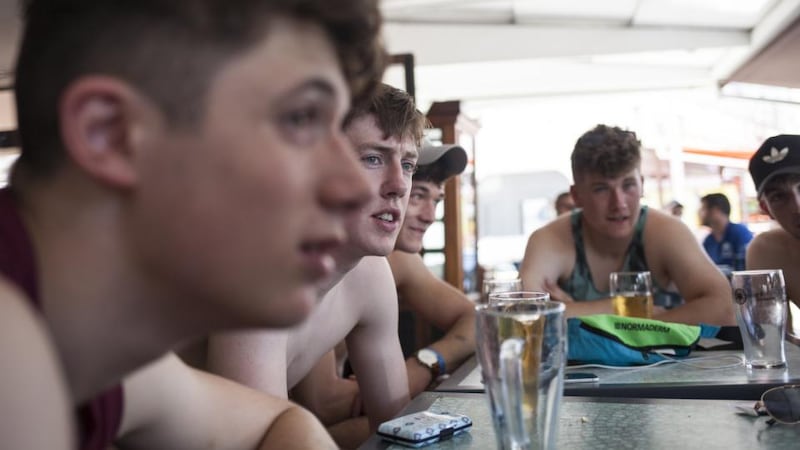
At the next table is a group of boys, also from Tipperary: Tom Creagh, Paddy “Levi” Heenan, Nathan Sheehan, Cliff Moloney, Jody Mitchel, Murt Flynn and John “Stoney” Hogan. They all attended the CBS in Nenagh. Most of them have pints of Amstel or Strongbow in front of them.
Why Majorca? Why Santa Ponsa?
“People who did the Leaving Cert last year told us about it, and that it was cheap,” says Sheehan.
While a lot of Irish teenagers in Majorca say the place is cheap, in fact eating out in Magaluf or Santa Ponsa is not particularly good value. What they actually mean is that alcohol is cheap.
“It’s only €10.95 for a litre of vodka,” says Creagh, who is wearing a GAA jersey.
“It’d be at least €24 at home,” says Sheehan.
“Also we heard that it’s full of Irish people here,” says Moloney.
They’re vague when asked how much they’ve been drinking. “A load of cocktails,” Hogan says, to guffaws.
“Easily a litre of vodka each every night,” says Sheehan. “With mixers.”
Most of the young Irish people in Majorca socialise in the groups they arrived with. They stay together at all times, whether eating, drinking, walking around, shopping, sunbathing or partying. They move in constant combinations of the eight, 12 or 25 people in their group – like sluggish but joyous centipedes. When I stop to talk to one person everyone else immediately stops, too, as if they are surgically attached to one other.
On June 12th, Jack Walsh, a 19-year-old from Askeaton, in Co Limerick, was found after falling 12m from the balcony of his apartment, in the Vista Club complex, in Santa Ponsa. He died two days later. One of triplets, Walsh had just arrived in Majorca to join friends after finishing an exam. It remains unclear what happened to Walsh, as nobody saw him fall and his body was not found until the morning.
When I mention Walsh to people I meet, they recognise his name and are respectful about the fact that he died. They also make it clear that, while they are sorry about it, they didn’t know him, and that his death had nothing to do with them. Bad things happen sometimes, unfortunately, say some.
“Put it this way: it didn’t stop any of us coming,” one person says.
“It’d make you think, though,” says another, downing his pint.
“Shit happens,” another says with a shrug.
Magaluf by day and Magaluf by night are two very different places, but Santa Ponsa, when I return at 11pm, is less dramatically changed from the daytime scene.
The bars, with their open-air terraces, are certainly crammed and noisy and buzzing, and people are walking around constantly in search of the next bar, but it still retains a small-town vibe and feels less volatile.
A group of friends from Carndonagh Community School, in Co Donegal, are sitting in a corner of Daniel’s Corner bar, around what looks like a fat see-through pipe that extends upwards like the pole of a parasol.
The pipe is half-full of a bright blue drink called a Blue Dolphin. When I ask what’s in it, nobody knows, other than venturing it’s “a cocktail”.
There are five litres of the stuff in the pipe, and it is costing the friends €10 a head – a deal that also includes shots and jugs of other drinks.
Why do so many lads wear GAA jerseys? 'So you don't have to buy new clothes. You can keep wearing the same thing'
“We came here because everyone comes here,” says DJ Friel, who is wearing a Donegal GAA jersey. He says that between this week and next more than 100 students from their school will be out in Santa Ponsa. “We’re not big drinkers,” he says, and everyone laughs.
The boys say they all paid for their holiday themselves through part-time jobs. Unlike the other groups of people I’ve talked to in Santa Ponsa, who all said they’d go for at least one night to Magaluf, this group has no intention of doing so. “There’s no point in going out in Magaluf, because they’re all English there,” Joseph Bugsy says.
“And it’s more expensive,” says Friel.
Why do so many lads wear GAA jerseys, I ask Thomas Dunne, from Glenmore in Co Kilkenny. He’s wearing a Kilkenny jersey.
“So you don’t have to buy new clothes,” he says. “You can keep wearing the same thing.”
During the course of the night I encounter one Irish boy from a group from Co Meath who is only dying to show me and the photographer his new tattoo. Uninvited, he drops his shorts at the bar and sticks out his bottom in the direction of the street.
On one buttock in small black writing is, “How’s your ma”. On the other is “your da not wurkin?” He makes sure we get a good look. As holiday tattoos go they’re baffling, opaque quotes.
At the Manhattan Bar, farther down the street from Daniel’s Corner, the cocktails come in large plastic penises with straws. Alex Dunne from Trim, in Co Meath, who’s sipping a strawberry daiquiri from one of them, is part of a group of 13.
Dunne actually did his Leaving Cert last year, but, like other of his friends, “we weren’t 18 last year, and our parents wouldn’t let us come then, so we’re here this year instead”.
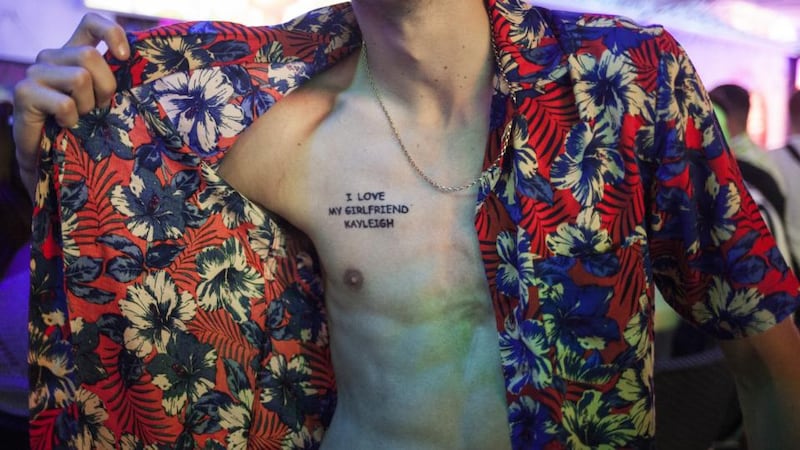
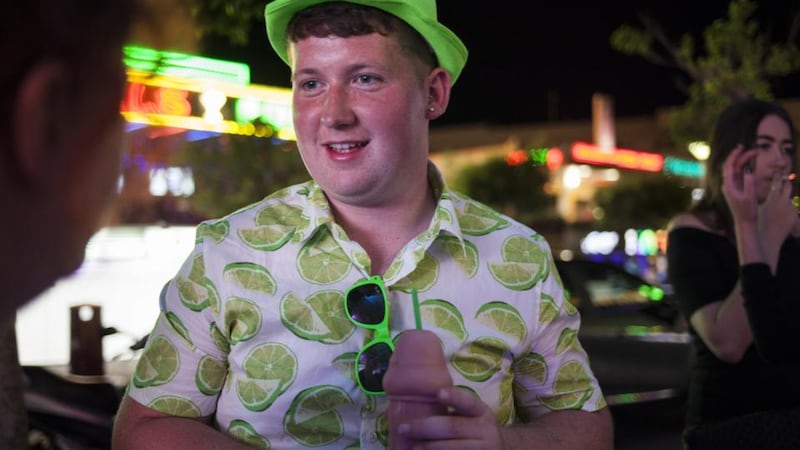
Dunne talks me through their days. They sleep from about 8am to 1pm, get up, and drink all day in the Manhattan, which is the closest bar to their accommodation. When it closes, at 3am, they go to the Green Hills, directly across the road, which stays open till 6am. Then they go to the beach.
They haven’t bothered exploring any other bars yet, although this is now their fifth day in Santa Ponsa. “We all look after each other,” he says. “The furthest any of us goes away from the other is to go to the toilet. Some people have to be carried upstairs sometimes if they’ve had too much.”
What was the attraction of Santa Ponsa?
“We heard it was supposed to be cheap, but to be honest I didn’t think the drink would be as cheap as it is,” he says. Dunne’s preferred drink of the past few days is an €8 jug of Sex on the Beach. “I’d have five or six of those,” he says. “Then a few shots: sambuca, tequila. A few Russian shots, vodka and peach schnapps. I get free shots sometimes. I lose count. You get to the end of the night and don’t really remember anything. I am definitely drinking too much. But you’re away from your parents, and I probably drink too much at home too.”
Outside a place called the Sinners Rest the photographer is surrounded by a group of Irish lads who want their picture taken. Arms around each other, they tell us that they have only just met each other.
“You come here to make friends, not to fight,” says Reece Rodriguez, from Muff, in Co Donegal. He’s a charismatic character who somehow organises several people he has only just met into posing for a group shot, and making sure each person has a cigarette for the photograph, whether they want one or not.
It’s true that everyone is drinking a lot, but it’s also true that most people seem to be thoroughly enjoying themselves, and looking out for each other.
I don’t see anyone fighting, or crying, or making a scene, although as the night progresses I do see an awful lot of people staggering around and beginning to get sick.
All along the pavements are pairs of young people in a familiar pose: one friend sitting behind the one who is stooped over, getting sick, holding on to their shoulders, or keeping their hair out of their face. A series of little pietas.
This article was edited on Tuesday July 3rd











